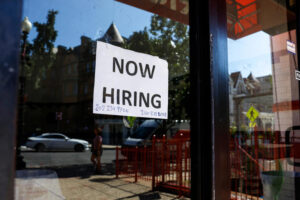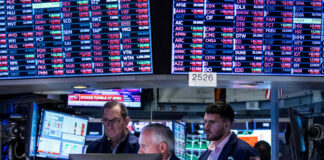DECEMBER 2, 2022

The Labor Department announced that in the month of November the U.S. added 263,000 jobs as the unemployment rate held steady at 3.7%. – Anna Moneymaker, Getty Images
U.S. employers added 263,000 jobs in November as hiring remained sturdy despite rising interest rates, high inflation and mounting recession worries.
The unemployment rate held steady at 3.7%, the Labor Department said Friday.
Economists surveyed by Bloomberg estimated that 200,000 jobs were added last month.
Payroll gains were revised down by 46,000 to 269,000 for September but up by 23,000 to 284,000 for October, lowering advances for the two months by a trivial 23,000 and leaving intact the portrait of a gradually slowing but remarkably resilient labor market.
The report likely will not be welcomed by a Federal Reserve looking for the supply of available workers to increase and job and wage growth to throttle back to cool inflation that, at 7.7%, is just modestly below a 40-year high. And that could mean continued aggressive interest rate hikes aimed at tempering price increases, a development that likely would batter stock markets that have rallied on hopes of slowing rate increases.
“Ironically, by pushing the (Fed) to raise rates further, continued strong job growth makes a near-term recession more likely,” says Gus Faucher, chief economist of PNC Financial Services Group.
Capital Economics and Nationwide, among other research firms, still expect the Fed to dial back to a half point rate increase this month after four straight three-quarter point bumps.
Labor force participation rate
In November, the share of adults working or looking for a job edged down to 62.1%, leaving it well below the pre-pandemic level of 63.4%. The labor force participation rate generally had been rising since 2020 as workers returned to a hot labor market after caring for children or staying idle because of COVID-19 fears.
But that share has roughly held steady this year, underscoring that most Americans intent on returning to the workforce have done so, especially baby boomers who retired early during the pandemic. That could keep pay increases elevated as employers compete for a more limited pool of workers, forcing companies to raise prices further to maintain profits.
Last month, average hourly wages rose 18 cents to $32.82, pushing the annual increase to 5.1% from 4.7% the previous month. Pay increases had been moderating and many economists expected a further decline in November.
Stock market, 10-year notes today
Stocks opened lower following the release of the report. The Dow Jones Industrial Average was down 0.9%. The Nasdaq Composite and S&P 500 were both down by more than 1% as of 9:44 a.m. EST. Yields on 10-year U.S. Treasury notes rose to 3.57% Friday morning.
Industries hiring
Leisure and hospitality, the industry hit hardest by the pandemic, led the job gains with 88,000, mostly in restaurants and bars. Employment in the sector is still nearly 1 million below its pre-COVID level, though U.S. payrolls overall recovered all 22 million jobs lost in the crisis in August.
Health care added 45,000 jobs; construction, 20,000; manufacturing, 14,000; and transportation and warehousing, 15,000.
Retailers shed 30,000 jobs after seasonal adjustments because the industry added far fewer holiday workers that it has historically.
Despite its resilience, the labor market has gradually cooled down this year. Job growth has moderated from a pace of about 450,000 for most of 2022 to under 300,000 in recent months. High inflation and the Fed’s sharp rate hikes have hobbled rate-sensitive sectors such as housing and technology.
Amazon, DoorDash layoffs mount
Tech giants Meta, Twitter, Amazon, DoorDash and Lyft, among many others, have announced a total of more than 142,000 layoffs this year.
Overall, initial jobless claims, a reliable gauge of job cuts, rose modestly in November but remain historically low, averaging 221,000 a week, Goldman Sachs says. Pandemic-induced labor shortages have made companies reluctant to chop workers on concerns they won’t be able to replace them when the economy bounces back.
2023 recession?
Still, a labor market that was blistering earlier this year is losing some steam. Most economists are forecasting a recession next year as the Fed continues to hike rates, leading some companies to leave positions vacant when employees leave and freeze hiring. There were 10.3 million job openings in October, down from 10.7 million the previous month.
Employment gains are also slowing because the nation in August completed its recovery of all 22 million jobs lost in the early days of the pandemic, says Ian Shepherdson, chief economist of Pantheon Macroeconomics.
Some industries are still catching up. Leisure and hospitality – which includes restaurants, bars and hotels – remains 980,000 jobs shy of its pre-COVID level and could continue to add workers at a solid clip as more Americans return to dining out and traveling, says Julia Pollak, chief economist of ZipRecruiter.
All told, Moody’s Analytics expects average monthly job growth to average about 76,000 in 2023, which would be the weakest showing in recent memory aside from the recessions of 2007-09 and 2020.
Courtesy/Source: This article originally appeared on USA TODAY










































































































